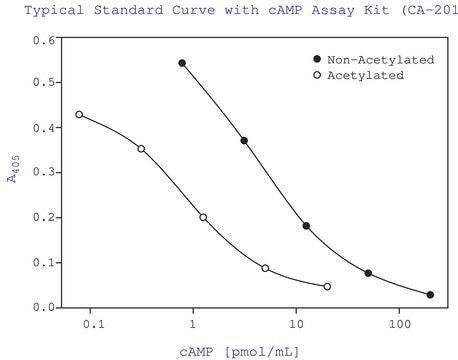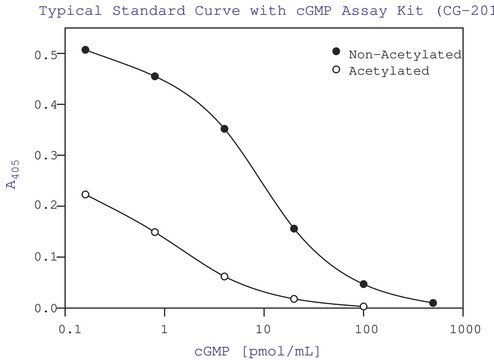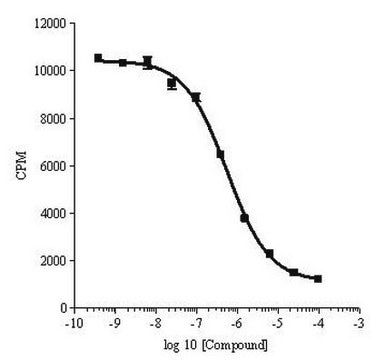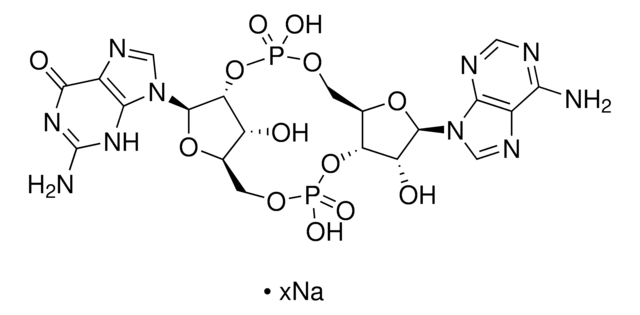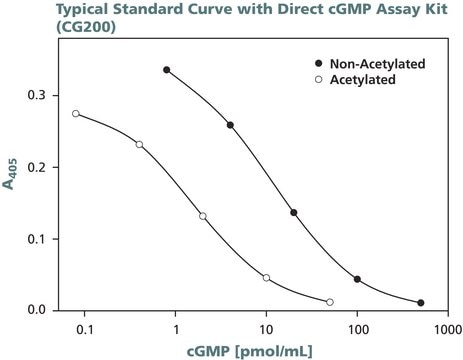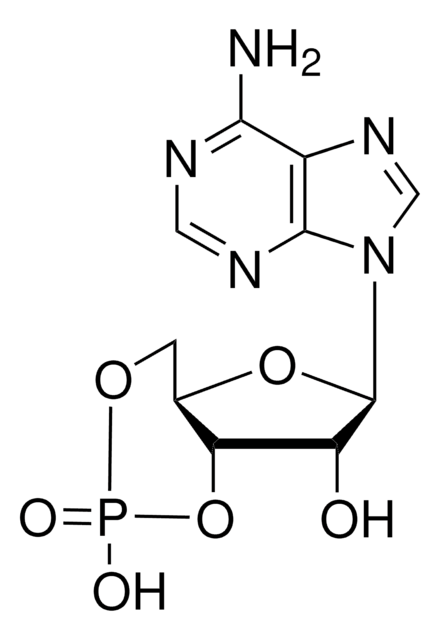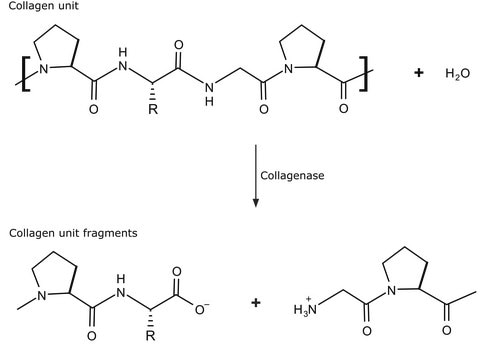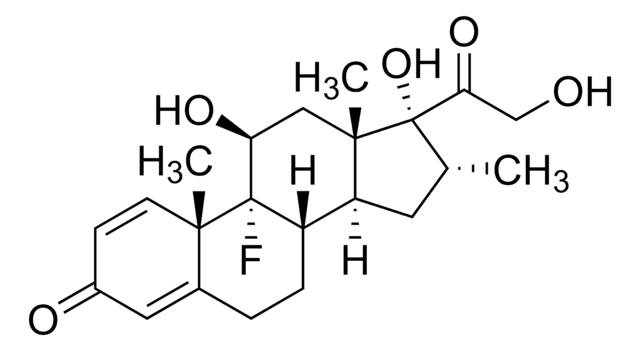CA200
cAMP Enzyme Immunoassay Kit, Direct
Synonym(s):
cAMP detection kit
Sign Into View Organizational & Contract Pricing
All Photos(1)
About This Item
UNSPSC Code:
12161503
NACRES:
NA.84
Recommended Products
General description
Adenosine 3′,5′-cyclic monophosphate (cAMP) is a second messenger in many physiological processes. It is synthesized from adenosine triphosphate (ATP) in the presence of enzyme adenylate cyclase.
Non-radioactive, competitive immunoassay for the quantitation of total cAMP in tissue and cell cultures treated with .1M HCL.The kit cAMP uses a cAMP polyclonal antibody to competitively bind the cAMP in the sample or alkaline phosphatase moleule that has cAMP covalently attachd to it.
Application
Please refer to the attached Protocolfor details.
cAMP Enzyme Immunoassay Kit, Direct has been used to measure cAMP levels in cell culture medium virulent and attenuated macrophages. It has also been used to quantify cAMP synthesis in olfactory epithelium.
Biochem/physiol Actions
Adenosine 3′,5′-cyclic monophosphate (cAMP) is shown to be involved in the cardiovascular and nervous systems, immune mechanisms, cell growth and differentiation, and general metabolism. Deciphering cAMP modulation in regulatory pathways may help in understanding of the physiology and pathology of many disease states.
Other Notes
Allow reagents to warm at room temperature for 30 minutes prior to opening.
Kit Components Only
Product No.
Description
- 0.1 M Hydrochloric Acid 1 x 30
- Acetic Anhydride 1 x 1
- cAMP-Alkaline Phosphatase Conjugate 1 x 5
- cAMP EIA Antibody Rabbit Anti-cAMP 1 x 5
- 5 Cycle Logit-Log Paper 1 x 1
- Cyclic AMP Standard 1 x 0.5
- Direct cAMP Assay Layout Sheet 1 x 1
- Goat Anti-Rabbit IgG Coated 96 Well Microtiter Plate 1 ea
- Neutralizing Reagent 1 x 6
- p-Nitrophenyl Phosphate Substrate Solution 1 x 20
- Plate Sealer 1 ea
- Stop Solution 1 x 5
- Triethylamine 1 x 2
- Wash Buffer Concentrate 1 x 30
See All (14)
signalword
Danger
Hazard Classifications
Acute Tox. 2 Inhalation - Acute Tox. 3 Dermal - Acute Tox. 4 Oral - Eye Dam. 1 - Flam. Liq. 3 - Met. Corr. 1 - Skin Corr. 1A - STOT SE 3
target_organs
Respiratory system
supp_hazards
wgk_germany
WGK 3
flash_point_f
120.2 °F
flash_point_c
49 °C
Certificates of Analysis (COA)
Search for Certificates of Analysis (COA) by entering the products Lot/Batch Number. Lot and Batch Numbers can be found on a product’s label following the words ‘Lot’ or ‘Batch’.
Already Own This Product?
Find documentation for the products that you have recently purchased in the Document Library.
Neha Gupta et al.
The International journal of developmental biology, 62(4-5), 273-283 (2018-06-08)
The etoposide-induced 2.4 kb transcript (ei24) gene is induced both by p53 and etoposide, an anti-cancer tumour drug. There is no p53 gene present in Dictyostelium discoideum. Thus, the functions of ei24 in the absence of p53 were analysed. Both
Haemodynamic and extracellular matrix cues regulate the mechanical phenotype and stiffness of aortic endothelial cells.
Collins C, Osborne LD, Guilluy C, et al.
Nature Communications, 5, 3984-3984 (2014)
Anna Maria D'Ursi et al.
Molecular pharmacology, 69(3), 727-736 (2005-12-08)
Cell-penetrating peptides are able to transport covalently attached cargoes such as peptide or polypeptide fragments of endogenous proteins across cell membranes. Taking advantage of the cell-penetrating properties of the 16-residue fragment penetratin, we synthesized a chimeric peptide that possesses an
Murali K Yanda et al.
The Journal of biological chemistry, 293(29), 11513-11526 (2018-06-08)
Autosomal dominant polycystic kidney disease (ADPKD) is associated with progressive enlargement of cysts, leading to a decline in function and renal failure that cannot be prevented by current treatments. Mutations in pkd1 and pkd2, encoding the polycystin 1 and 2
Sujoy Das et al.
PloS one, 5(8), e12039-e12039 (2010-08-14)
Several studies have been reported on the occurrence of sperm motility inhibiting factors in the male reproductive fluids of different mammalian species, but these proteins have not been adequately purified and characterized. A novel sperm motility inhibiting factor (MIF-II) has
Our team of scientists has experience in all areas of research including Life Science, Material Science, Chemical Synthesis, Chromatography, Analytical and many others.
Contact Technical Service